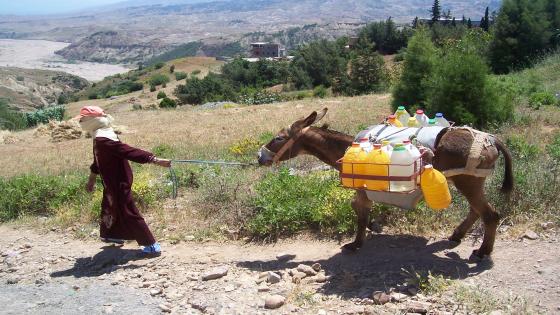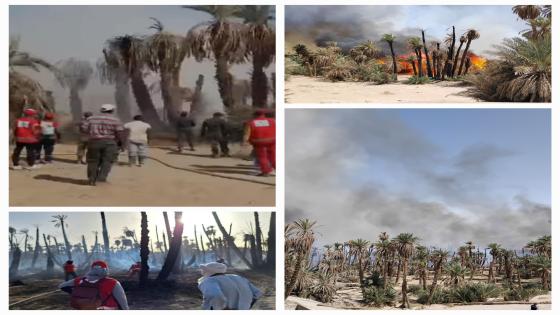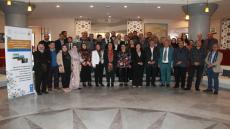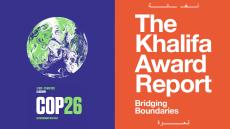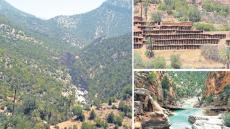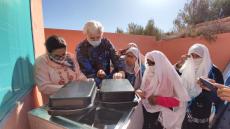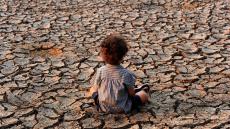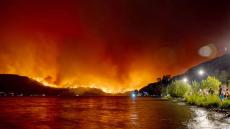Inhabitants of Morocco’s northern region adapt to climate change by storing rainwater, developing resilient crops, preventing soil erosion.
By Mohammed Tafraouti – BOUMAAD, Morocco
There is not avoiding the mighty “Ameqrane” River as we set out from the village of Boudinar towards the village of Boumaad and later on that of “Tiza”. Scattered tree limbs, water rivulets flowing soundlessly, and murky puddles of stagnant water wallow in far corners, like desperate liquid pools bowing shyly before the majesty of the great river.
On the left bank, a strip of water stubbornly forges its way into the great river, like a snake slithering purposefully towards a well known destination, laden with water as if fed by a clear source in the upper reaches of the mountain, meandering and gushing with such force that no finality seems possible other than embracing the folds of the Mediterranean sea.
A beautiful herd of predominantly dark brown goats graze, spattered with a few famished sheep greedily searching for grass to ease the signs of underfeeding that clearly mark their frames.
The two 4X4 hurry along to reach” Boumaad “village through the “Ameqrane” valley, turning left and then right in search of an easy path to their final destinations: the village of “Boumaad” and later on that of “Tiza”.
A man, busy sifting pebbles and sand in the middle of the river raises his head inquisitively at the passage of the vehicles. Piled by his side are two meager heaps of sand.
Finally, and after a 45 minute drive along the river, a turn takes us away from the river bank and up the mountain as we embark on a maze of turns and twists. Clouds of dust rise around us, blocking our visibility at times and forcing us to inch along in our climb up the mountain. The narrow dirt road takes us towards the village/summit where the population lives and from where we can admire the imposing majesty of the “Ameqrane” River.
Tiza Village
The inhabitants of “Tiza” Village depend on traditional subsistence cultures and annual crops of grains, legumes, olives, some fruits and animal breeding. Unfortunately, climate changes have adversely impacted on these traditional cultures, rendering them less profitable and more detrimental to the local environmental system.
The fertile clay soil of the region has greatly deteriorated as a result of erosion and the soil and underground water salinity which results from the rising sea level of the Mediterranean Sea.
The land, source of livelihood for the population, is today threatened by soil erosion, floods and droughts. These phenomena shrink the surface area of arable land and undermine the plant cover, destroying in the process the ecosystem and the basic structure. This in turn exacerbates poverty and rural migration, particularly among the young men.
The populations of ” Boumaad” and “Tiza” bear up against exceptionally violent rain storms which cause the Ameqrane River to well up in destructive floods, cutting off the villages from the rest of the collectivity.
On the other hand, the region suffers severe droughts which severely affect a population that depends entirely on natural resources harvesting and mostly rain fed agriculture.
Adaptation to Climate Change and Preserving Resources
A field study conducted by the research team of the Adaptation to Climate Change in Morocco (ACCMA), a project funded in the framework of Adaptation to Climate Change in Africa (ACCA) program, jointly funded by the International Development Research Center (Canada) and the Department for International Development (DFID) of the United Kingdom, documented the impact of sea level rise and extreme weather events on the natural and socioeconomic systems. Sea water intrusion, beach and soil erosion are among identified impacts. Such changes will negatively affect living conditions in the region as well as disrupt the ecological order, exacerbating the vulnerability of the social and economic structure of the region.
The scientific study carried out by ACCMA and the consultation meetings with stakeholders, focused on the necessity of adapting to climate change and improving the living conditions of the population in the villages of Boumaad and Tiza in the eastern part of the Rif (between Al Hoceima and Nador and close to the Mediterranean Sea). These efforts, which take shape within the framework of a joint program involving the inhabitants of the two far apart villages and the program for adaptation to climate change, comprise the collection of rainwater and the development of new farming and soil preservation techniques, the aim being to sustain the local ecological system, break the isolation of the region and support local adaptive capacities.
Doctor Abdellatif Khattabi, ACCMA coordinator and Professor at the National School for Forest Engineers, confirms that climate change forecasts performed by ACCMA predict an increase in temperatures, a drop in rainfall levels, a worsening of droughts coupled with a sharp discrepancy between water demand and offer. The drop in rainfall levels, mainly during the spring season in the area under study will adversely impact on the local agricultural activity, and ultimately on the community’s scarce resources.
Khattabi goes on to say that the study conducted seeks to build the local populations’ capacity to adapt to climate change impacts and improve their living conditions through improvement of agricultural and water management practices, and the implementation of measures that promote income generating activities.
Outcome and Achievements
Detailed soil and water management strategies have been devised in order to guarantee a good adaptation to drought and erosion. New climate change adaptation practices were identified for implementation in cooperation with the inhabitants to achieve the sustainable development of their living conditions. Such practices include the selection of tree varieties that adapt easily to water scarcity, soil salinity and erosion, such as olive, carob, almond and fig trees, alternative farming techniques that promote high value-added crops, building a reservoir to store the water resources available in the village, digging new reservoirs and favoring the drip irrigation system, as well as testing and applying new techniques aimed at sustaining soil quality.
To build the capacity of the community to face up to the negative impacts of climate change, the ACCMA project has organized several training workshops benefiting the targeted populations. The workshops enable them acquire new skills and know-how in climate change adaption through, inter alia, water management, maintenance of rainwater catchment reservoirs and the sustainable maintenance of local crops. The purpose of these exercises is to improve living conditions, alleviate poverty and vulnerability within families, halt or at least reduce rural exodus, and contain the risks of soil erosion and therefore preserve the echo-system and local agriculture.
Obstacles and Impediments
Community activities within the Tiza village are not made any easier by the distances separating houses but this obstacle can be overcome through the intensified mobilization of local communities by tapping into local solidarity traditions. Another obstacle, this one cultural, is reluctance to involve women despite the important role they play in managing natural resources and the fact that they stand deeply affected by climate changes, mainly water scarcity. However, the Tafedna Association for Development and Solidarity, with the help of ACCMA project and the Community Based Adaptation Program (CBA) is now promoting and organizing activities that target women in various contexts and with the assistance of various other role-players advocating women’s rights.
Boumaad Village and Impact of Climate Change on Women in an Agricultural Society
The ACCMA study is aimed at building women’s capacity to acclimatize their local agricultural environment to climate changes, particularly to the challenges of dwindling water resources, impoverished plant cover, soil erosion, the loss of crops and cattle and the destruction of environment and basic structures. The project will extend assistance through improving water management and storage, increasing water proximity to women to alleviate the hardships linked to water conveyance and bettering their living conditions. It will also benefit farmers who will be provided with water for irrigation purposes.
Women account for 75% of the village’s population since most men have either temporarily or definitely migrated in the search of greener pastures. Subsistence in the village relies on the traditional growing of annual crops supplemented by sheep farming and beekeeping, fishing and commerce, although these contribute to a lesser extent to income. Women play a major role in the agricultural process at the various stages of land farming: tilling, irrigation, weeding, preservation of fields and crops, harvesting and storage of the agricultural produce.
“Boumaad” village suffers from the absence of a connection to the piped potable water with some of the houses being located more than 1.5 kilometers from the nearest drinking water source. In fact, a woman may spend up to one hour and a half per day carrying water to be used for drinking, household chores, farming and irrigation.
Professor Abdellatif Khattabi explains that women at “Boumaad” suffer tremendously from the direct impact of climate change on their lives. A woman is therefore more vulnerable to the effects of climate change considering the efforts expended in ferrying water through strenuous paths, a chore that leaves little time left for other activities.
Unlike men, a woman cannot leave the village to find other sources of income. She depends on local resources such as the rapidly swindling cultures, a situation further compounded by the almost nil educational opportunities open to women. This situation has drawn the attention of the ACCMA project which strives to provide an opportunity for the population, particularly women, to acquire new skills and engage in diversified activities with the help and participation of local associations. The project will help women tackle all these vulnerability factors, and this help will include a literacy program for women and girls from the village, laying pipes to convey drinking and irrigation water from its sources, building a small reservoir close to the water sources, and adopting a pilot project of drip irrigation for a better management of limited water resources. It also seeks to improve women’s knowledge about climate changes, the application of rationalized farming and water management techniques through the process of information and expertise sharing that takes place during the field visits to the sites of other projects.

